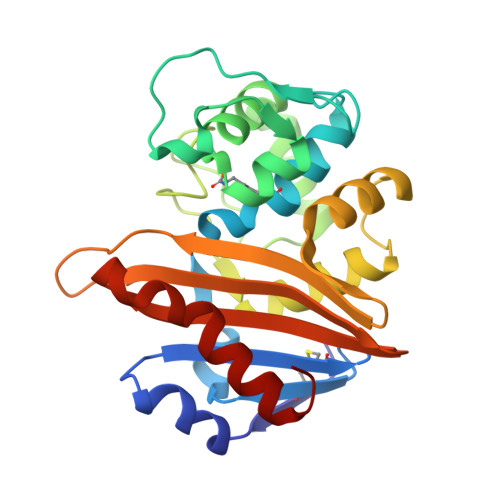(13)C-Carbamylation as a mechanistic probe for the inhibition of class D beta-lactamases by avibactam and halide ions.
Lohans, C.T., Wang, D.Y., Jorgensen, C., Cahill, S.T., Clifton, I.J., McDonough, M.A., Oswin, H.P., Spencer, J., Domene, C., Claridge, T.D.W., Brem, J., Schofield, C.J.(2017) Org Biomol Chem 15: 6024-6032
- PubMed: 28678295
- DOI: https://doi.org/10.1039/c7ob01514c
- Primary Citation of Related Structures:
5MMY, 5MNU, 5MOX, 5MOZ - PubMed Abstract:
The class D (OXA) serine ¦Â-lactamases are a major cause of resistance to ¦Â-lactam antibiotics. The class D enzymes are unique amongst ¦Â-lactamases because they have a carbamylated lysine that acts as a general acid/base in catalysis. Previous crystallographic studies led to the proposal that ¦Â-lactamase inhibitor avibactam targets OXA enzymes in part by promoting decarbamylation. Similarly, halide ions are proposed to inhibit OXA enzymes via decarbamylation. NMR analyses, in which the carbamylated lysines of OXA-10, -23 and -48 were 13 C-labelled, indicate that reaction with avibactam does not ablate lysine carbamylation in solution. While halide ions did not decarbamylate the 13 C-labelled OXA enzymes in the absence of substrate or inhibitor, avibactam-treated OXA enzymes were susceptible to decarbamylation mediated by halide ions, suggesting halide ions may inhibit OXA enzymes by promoting decarbamylation of acyl-enzyme complex. Crystal structures of the OXA-10 avibactam complex were obtained with bromide, iodide, and sodium ions bound between Trp-154 and Lys-70. Structures were also obtained wherein bromide and iodide ions occupy the position expected for the 'hydrolytic water' molecule. In contrast with some solution studies, Lys-70 was decarbamylated in these structures. These results reveal clear differences between crystallographic and solution studies on the interaction of class D ¦Â-lactamases with avibactam and halides, and demonstrate the utility of 13 C-NMR for studying lysine carbamylation in solution.
Organizational Affiliation:
Department of Chemistry, University of Oxford, Oxford, OX1 3TA, UK. christopher.schofield@chem.ox.ac.uk jurgen.brem@chem.ox.ac.uk.





















